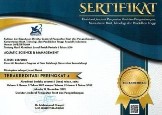Ratio of C:N in culture media of silk worm, Tubifex sp.
Abstract
Title (Bahasa Indonesia): Rasio C:N pada media kultur cacing sutra, Tubifex sp.
This study aimed to determine the C:N ratio on each medium for the growth of the sludge worm. This study used mud and soybean curd residue (treatment A), mud and chicken manure (treatment B), mud and pig manure (treatment C), and control (mud only) (K) as culture media of the sludge worm (Tubifex sp.). The decomposition process was proceeding for six days, and then the sludge worms were stocked with initial weight of 30 grams per container. Culture period was 21 days in running water systems. The resulting C:N ratio was 60.5 for treatment A, 45.8 for treatment B, 36 for treatment C and 35 for K. The soybean curd residue and mud medium gave the highest influence on the growth of the sludge worm, followed by pig manure and mud, chicken manure and mud, and then mud (control).
Penelitian ini bertujuan untuk menentukan perbandingan C:N ratio dalam media budidaya untuk pertumbuhan cacing sutra. Penelitian ini menggunakan lumpur dan ampas tahu (perlakuan A), lumpur dan kotoran ayam (perlakuan B), serta lumpur dan kotoran babi (perlakuan C) dan perlakuan K (kontrol: hanya lumpur) sebagai media kultur cacing sutra (Tubifex sp). Proses dekomposisi dilakukan selama 6 hari, kemudian dilakukan penebaran cacing sutra dengan berat awal 30 gram/wadah penelitian. Waktu pemeliharaan dilakukan selama 21 hari dalam sistem air mengalir. Hasil penelitian menunjukkan rasio C:N sebesar 60,55 untuk perlakuan A, 45,85 untuk perlakuan B, 36,08 untuk perlakuan C, dan 35,25 untuk K. Media yang menggunakan ampas tahu dan lumpur memberikan pengaruh tertinggi terhadap pertumbuhan cacing sutra, kemudian disusul oleh media kotoran babi dan lumpur, media kotoran ayam dan lumpur dan terendah media lumpur (kontrol).
Keywords
Full Text:
PDFReferences
ANONIMOUS. (2011) Decomposition of Soil Organic Matter [WWW] Available from :http://www.agriinfo.in/?page=topic&superid=4&topicid=288 [Accessed 05/08/14].
ASARY, A.A and RAJPERSAUD, J. (2012) Physicochemical Changes during Vermicom-posting of Water Hyacinth (Eichhornia crassipes) and Grass Clippings. International Scholarly Research Notices Soil Science, pp1- 6.
EDWARDS, C.A. (1998) The use of earthworms in the breakdown and management of organic wastes. – In: Edwards, C.A. (ed.): Earthworm Ecology. St. Lucie Press, Boca Raton, pp. 327-351.
GARG, V.K., and KAUSHIK, P. (2005) Vermistabilization of textile mill sludge spiked with poultry droppings by an epigeic earthworm Eisenia foetida. Bioresource Technology, 96 (9), pp. 1063-1071.
GRAY, C.(2014) How Long Does Chicken Manure Have to Age to Use As Fertilizer [WWW] http://homeguides.sfgate.com /long-chicken-manure-age-use-fertilizer-43419.html [Accessed 31/07/14].
HOORMAN, J.J and ISLAM, R. (2010) Understanding soil microbes and Nutrient recycling. Fact Sheet, Agriculture and Natural Resources. The Ohio State University, pp 1-5.
HOSSAIN, A., HASAN M. and MOLLAH, M.F.A. (2011) Effects of soybean meal and mustard oil cake on the production of fish life food tubificid worms in Bangladesh. World
Journal of Fish and Marine Sciences, 3 (3), pp. 183-189.
JUSOFF, K. (2009) Influences of Bedding Material in Vermicomposting Process. International Journal of Biology, 1 (1), pp. 81-91.
LI, S., ZHU, D., LI, K., YANG, Y., LEI, Z., and ZHANG, Z. (2013) Soybean curd residue: Composition, utilization and related limiting factors. International Scholarly Research Notices Industrial Engineering, pp 1-8.
MANAF, L.A, JUSOH, M.L.C., YUSOFF, M.K., ISMAIL, T.H.T., HARUN, R. and JUAHIR, H. (2009) Influences of Bedding Material in Vermicomposting Process. International Journal of Biology, 1 (1), pp. 81-91.
PANCAPALAGA, W. (2011) Pengaruh rasio penggunaan limbah ternak dan hijauan terhadap kualitas pupuk cair. Gamma, 7 (1), pp. 61- 68.
PRIYAMBODO, K and WAHYUNINGSIH, T. (2002) Budidaya Pakan Alami Untuk Ikan. Jakarta:Penebar Swadaya.
SUTHAR, S. (2006) Potential utilization of guargum industrial waste in vermicompost production. Bioresource Technology, 97, pp. 2474-2477.
DOI: https://doi.org/10.35800/jasm.2.1.2014.12391
Refbacks
- There are currently no refbacks.
INDEXED IN:
PUBLISHER: The JASM is published by Pascasarjana, Universitas Sam Ratulangi, Manado, in collaboration with the Indonesia of Aquatic Resources Management Association (Asosiasi Pengelola Sumber Daya Perairan Indonesia/SIPESUAR). It is printed in each publication as 'Graduate Program, UNSRAT, Manado, Indonesia – Asosiasi Pengelola Sumber Daya Perairan Indonesia'.








